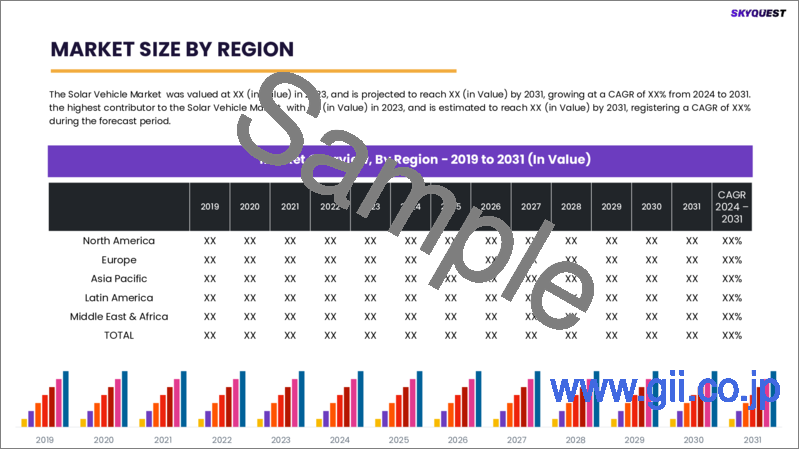|
|
市場調査レポート
商品コード
1396194
ソーラーカーの世界市場規模、シェア、成長分析、タイプ別、用途別- 産業予測 、2023-2030年Global Solar Vehicle Market Size, Share, Growth Analysis, By Type(Passenger Vehicles and Commercial Vehicles), By Application(Personal Use and Fleet Operations) - Industry Forecast 2023-2030 |
||||||
| ソーラーカーの世界市場規模、シェア、成長分析、タイプ別、用途別- 産業予測 、2023-2030年 |
|
出版日: 2023年11月15日
発行: SkyQuest
ページ情報: 英文 157 Pages
納期: 3~5営業日
|
- 全表示
- 概要
- 目次
ソーラーカーの世界市場規模は2021年に8,000万米ドルと評価され、2022年の3億6,000万米ドルから2030年には13億6,000万米ドルに成長し、予測期間(2023-2030年)のCAGRは20.1%で成長する見通しです。
世界のソーラーカー市場は著しい成長を遂げており、従来の化石燃料を動力とする自動車に代わる有望な選択肢として浮上しています。ソーラーカーは、太陽エネルギーを利用して発電し、その電力で推進システムを動かします。このクリーンで再生可能なエネルギー源は、温室効果ガスの排出と化石燃料への依存を削減し、ソーラーカーを環境に優しい輸送ソリューションにしています。世界のソーラーカー市場の成長を促す主な要因の一つは、気候変動に対する意識の高まりと、持続可能な交通手段の必要性です。世界中の政府や規制機関は、ソーラーカーの導入を促進するため、厳しい排出基準を導入し、インセンティブを提供しています。このため、研究開発活動が活発化し、技術が進歩し、ソーラーカー分野への投資が増加しています。市場では、ソーラーカー、ソーラーバス、ソーラーバイクなど、さまざまなソーラー自動車が見られます。特にソーラーカーは、効率の向上、走行距離の延長、バッテリー技術の向上により人気を集めています。企業や新興企業は、ソーラーカーの性能と美観を向上させるため、革新的なデザインや素材を積極的に開発しています。ソーラーカー市場は依然として、高コスト、限られたインフラ、技術的限界といった課題に直面しているが、ソーラー技術の継続的な進歩と政府の有利な政策が、今後数年間の市場成長を促進すると予想されます。さらに、自動車メーカー、ソーラーパネルメーカー、エネルギー企業間の協力関係が、ソーラーカーの開発と普及を加速させています。
ソーラーカーの世界市場セグメント分析
世界のソーラーカー市場は、タイプ、用途、地域別に区分されます。タイプ別では、乗用車、商用車に区分されます。用途別では、個人用とフリート用に区分されます。地域別では、北米、欧州、アジア太平洋、中東・アフリカ、ラテンアメリカに区分されます。
世界のソーラーカー市場の促進要因
環境維持に対する意識と関心の高まり:
世界のソーラーカー市場の拡大を促進する重要な要因は、環境の持続可能性に関する意識と関心の高まりです。二酸化炭素排出量の削減と気候変動への対応が重視されるようになり、よりクリーンな代替交通手段への需要が急増しています。再生可能エネルギー源を活用したソーラーカーは、温室効果ガスの排出を大幅に削減し、化石燃料への依存度を下げるという魅力的なソリューションを提供します。この原動力により、政府、消費者、自動車メーカーはソーラー車両技術への投資を促し、世界規模での普及を提唱しています。
世界のソーラーカー市場の抑制要因
ソーラーカー技術に伴う初期コストの高さ:
世界のソーラーカー市場の成長を阻害する主な要因は、ソーラーカー技術に関連する多額の初期費用です。高効率ソーラーパネルや高度なエネルギー貯蔵システムのような特殊な部品は、車両全体のコストを大幅に上昇させる可能性があります。さらに、ソーラーカー用の充電インフラが限られていることも、普及への課題となっています。多額の先行投資とそれを支えるインフラの必要性は、潜在的な購入者がソーラー車両を選択する意欲をそぎ、市場の成長を鈍らせる可能性があります。
世界のソーラーカー市場の動向
世界のソーラーカー市場における注目すべき動向は、高度な自律走行技術の統合です。安全性、利便性、総合的なユーザー体験を高めるため、ソーラーカーに自律走行機能が組み込まれつつあります。この動向は、自動車業界で電気自動車や自律走行車への注目が高まっていることが後押ししています。太陽光発電と自律走行の融合は、効率的なエネルギー管理、最適化されたルート計画、シームレスな接続性を促進し、太陽光発電を利用した交通手段の未来を形成し、旅行体験に革命をもたらします。
目次
- エグゼクティブサマリー
- 調査手法
- 親市場の分析
- 主な市場の考察
- 技術分析
- 価格分析
- サプライチェーン分析
- バリューチェーン分析
- 市場のエコシステム
- IP分析
- 貿易分析
- スタートアップ分析
- 原材料の分析
- イノベーションマトリクス
- パイプライン製品の分析
- マクロ経済指標
- 主な投資の分析
- 主な成功要因
- 競合の程度
- 市場力学と見通し
- 市場力学
- 促進要因
- 機会
- 抑制要因
- 課題
- 規制情勢
- ポーターの分析
- 将来の混乱についての特別な考察
- 市場力学
- ソーラーカーの世界市場:タイプ別
- 市場概要
- 乗用車、商用車
- ソーラーカーの世界市場:用途別
- 市場概要
- 個人、フリート
- ソーラーカーの世界市場規模:地域別
- 市場概要
- 北米
- 米国
- カナダ
- 欧州
- ドイツ
- スペイン
- フランス
- 英国
- その他欧州地域
- アジア太平洋
- 中国
- インド
- 日本
- 韓国
- その他アジア太平洋地域
- ラテンアメリカ
- ブラジル
- その他ラテンアメリカ地域
- 中東・アフリカ(MEA)
- GCC諸国
- 南アフリカ
- その他中東・アフリカ地域
- 競合情勢
- 上位5社の比較
- 主要企業の市場ポジショニング(2021年)
- 主な市場企業が採用した戦略
- 主要成功戦略
- 市場における最近の活動
- 主要企業の市場シェア(2021年)
- 主要企業プロファイル
- Tesla(US)
- Toyota(Japan)
- Nissan(Japan)
- Hyundai(South Korea)
- BMW(Germany)
- Ford(US)
- Volkswagen(Germany)
- Audi(Germany)
- Honda(Japan)
- General Motors(US)
- BYD Auto(China)
- Kia Motors(South Korea)
- Solar Team Eindhoven(Netherlands)
- Sono Motors(Germany)
- Lightyear(Netherlands)
- Rivian(US)
- Lucid Motors(US)
- Aptera Motors(US)
- Jaguar Land Rover(UK)
- Polestar(Sweden)
Global Solar Vehicle Market size was valued at USD 0.08 billion in 2021 and is poised to grow from USD 0.36 billion in 2022 to USD 1.36 billion by 2030, growing at a CAGR of 20.1% during the forecast period (2023-2030).
The global solar vehicle market is experiencing significant growth and has emerged as a promising alternative to traditional fossil fuel-powered vehicles. Solar vehicles utilize solar energy to generate electricity, which powers their propulsion systems. This clean and renewable energy source reduces greenhouse gas emissions and dependence on fossil fuels, making solar vehicles an environmentally friendly transportation solution. One of the key factors driving the growth of the global solar vehicle market is the increasing awareness of climate change and the need for sustainable transportation options. Governments and regulatory bodies across the world are implementing stringent emission standards and offering incentives to promote the adoption of solar vehicles. This has led to a rise in research and development activities, technological advancements, and increased investments in the solar vehicle sector. The market is witnessing a range of solar-powered vehicles, including solar cars, solar buses, and solar-powered bikes. Solar cars, in particular, are gaining popularity due to their improved efficiency, longer driving ranges, and better battery technologies. Companies and startups are actively developing innovative designs and materials to enhance the performance and aesthetics of solar vehicles. Although the solar vehicle market still faces challenges such as high costs, limited infrastructure, and technological limitations, ongoing advancements in solar technology and favorable government policies are expected to drive market growth in the coming years. Furthermore, collaborations between automobile manufacturers, solar panel manufacturers, and energy companies are helping to accelerate the development and adoption of solar vehicles.
Top-down and bottom-up approaches were used to estimate and validate the size of the Global Solar Vehicle Market and to estimate the size of various other dependent submarkets. The research methodology used to estimate the market size includes the following details: The key players in the market were identified through secondary research, and their market shares in the respective regions were determined through primary and secondary research. This entire procedure includes the study of the annual and financial reports of the top market players and extensive interviews for key insights from industry leaders such as CEOs, VPs, directors, and marketing executives. All percentage shares split, and breakdowns were determined using secondary sources and verified through Primary sources. All possible parameters that affect the markets covered in this research study have been accounted for, viewed in extensive detail, verified through primary research, and analyzed to get the final quantitative and qualitative data.
Global Solar Vehicle Market Segmental Analysis
Global Solar Vehicle Market is segmented by type, application, and region. Based on type, the market can be segmented into passenger vehicles, and commercial vehicles. Based on application, the market is segmented into personal use, and fleet operations. Based on region, the market is segmented into North America, Europe, Asia Pacific, Middle East and Africa, and Latin America.
Drivers of the Global Solar Vehicle Market
Increasing Awareness and Concern about Environmental Sustainability:
A significant driver fostering the expansion of the global solar vehicle market is the growing awareness and concern regarding environmental sustainability. With an escalating emphasis on reducing carbon emissions and addressing climate change, there is a surging demand for cleaner transportation alternatives. Solar vehicles, leveraging renewable energy sources, provide an appealing solution by substantially lowering greenhouse gas emissions and reducing dependence on fossil fuels. This driver is prompting governments, consumers, and automotive manufacturers to invest in solar vehicle technologies and advocate for their widespread adoption on a global scale.
Restraints in the Global Solar Vehicle Market
High Initial Cost Associated with Solar Vehicle Technology:
A major restraint impeding the growth of the global solar vehicle market is the considerable initial cost linked with solar vehicle technology. Specialized components like high-efficiency solar panels and advanced energy storage systems can significantly elevate the overall vehicle cost. Additionally, the limited availability of charging infrastructure for solar vehicles poses a challenge to widespread adoption. The substantial upfront investment and the necessity for supportive infrastructure may discourage potential buyers from choosing solar vehicles, potentially slowing down market growth.
Market Trends of the Global Solar Vehicle Market
A noteworthy trend in the global solar vehicle market is the integration of advanced autonomous driving technologies. Autonomous capabilities are being embedded into solar vehicles to enhance safety, convenience, and overall user experience. This trend is propelled by the increasing focus on electric and autonomous vehicles in the automotive industry. The amalgamation of solar power and autonomous driving facilitates efficient energy management, optimized route planning, and seamless connectivity, shaping the future of solar-powered transportation and revolutionizing travel experiences.
Table of Contents
- Executive Summary
- Market Overview
- Wheel of Fortune
- Research Methodology
- Information Procurement
- Secondary & Primary Data Sources
- Market Size Estimation
- Market Assumptions & Limitations
- Parent Market Analysis
- Market Overview
- Market Size
- Market Dynamics
- Drivers
- Opportunities
- Restraints
- Challenges
- Key Market Insights
- Technology Analysis
- Pricing Analysis
- Supply Chain Analysis
- Value Chain Analysis
- Ecosystem of the Market
- IP Analysis
- Trade Analysis
- Startup Analysis
- Raw Material Analysis
- Innovation Matrix
- Pipeline Product Analysis
- Macroeconomic Indicators
- Top Investment Analysis
- Key Success Factor
- Degree of Competition
- Market Dynamics & Outlook
- Market Dynamics
- Drivers
- Opportunities
- Restraints
- Challenges
- Regulatory Landscape
- Porters Analysis
- Competitive rivalry
- Threat of Substitute Products
- Bargaining Power of Buyers
- Threat of New Entrants
- Bargaining Power of Suppliers
- Skyquest Special Insights on Future Disruptions
- Political Impact
- Economic Impact
- Social Impact
- Technical Impact
- Environmental Impact
- Legal Impact
- Market Dynamics
- Global Solar Vehicle Market by Type
- Market Overview
- Passenger Vehicles and Commercial Vehicles
- Global Solar Vehicle Market by Application
- Market Overview
- Personal Use and Fleet Operations
- Global Solar Vehicle Market Size by Region
- Market Overview
- North America
- USA
- Canada
- Europe
- Germany
- Spain
- France
- UK
- Rest of Europe
- Asia Pacific
- China
- India
- Japan
- South Korea
- Rest of Asia-Pacific
- Latin America
- Brazil
- Rest of Latin America
- Middle East & Africa (MEA)
- GCC Countries
- South Africa
- Rest of MEA
- Competitive Landscape
- Top 5 Player Comparison
- Market Positioning of Key Players, 2021
- Strategies Adopted by Key Market Players
- Top Winning Strategies
- By Development
- By Company
- By Year
- Recent Activities in the Market
- Key Companies Market Share (%), 2021
- Key Company Profiles
- Tesla (US)
- Company Overview
- Business Segment Overview
- Financial Updates
- Key Developments
- Toyota (Japan)
- Company Overview
- Business Segment Overview
- Financial Updates
- Key Developments
- Nissan (Japan)
- Company Overview
- Business Segment Overview
- Financial Updates
- Key Developments
- Hyundai (South Korea)
- Company Overview
- Business Segment Overview
- Financial Updates
- Key Developments
- BMW (Germany)
- Company Overview
- Business Segment Overview
- Financial Updates
- Key Developments
- Ford (US)
- Company Overview
- Business Segment Overview
- Financial Updates
- Key Developments
- Volkswagen (Germany)
- Company Overview
- Business Segment Overview
- Financial Updates
- Key Developments
- Audi (Germany)
- Company Overview
- Business Segment Overview
- Financial Updates
- Key Developments
- Honda (Japan)
- Company Overview
- Business Segment Overview
- Financial Updates
- Key Developments
- General Motors (US)
- Company Overview
- Business Segment Overview
- Financial Updates
- Key Developments
- BYD Auto (China)
- Company Overview
- Business Segment Overview
- Financial Updates
- Key Developments
- Kia Motors (South Korea)
- Company Overview
- Business Segment Overview
- Financial Updates
- Key Developments
- Solar Team Eindhoven (Netherlands)
- Company Overview
- Business Segment Overview
- Financial Updates
- Key Developments
- Sono Motors (Germany)
- Company Overview
- Business Segment Overview
- Financial Updates
- Key Developments
- Lightyear (Netherlands)
- Company Overview
- Business Segment Overview
- Financial Updates
- Key Developments
- Rivian (US)
- Company Overview
- Business Segment Overview
- Financial Updates
- Key Developments
- Lucid Motors (US)
- Company Overview
- Business Segment Overview
- Financial Updates
- Key Developments
- Aptera Motors (US)
- Company Overview
- Business Segment Overview
- Financial Updates
- Key Developments
- Jaguar Land Rover (UK)
- Company Overview
- Business Segment Overview
- Financial Updates
- Key Developments
- Polestar (Sweden)
- Company Overview
- Business Segment Overview
- Financial Updates
- Key Developments
- Tesla (US)




